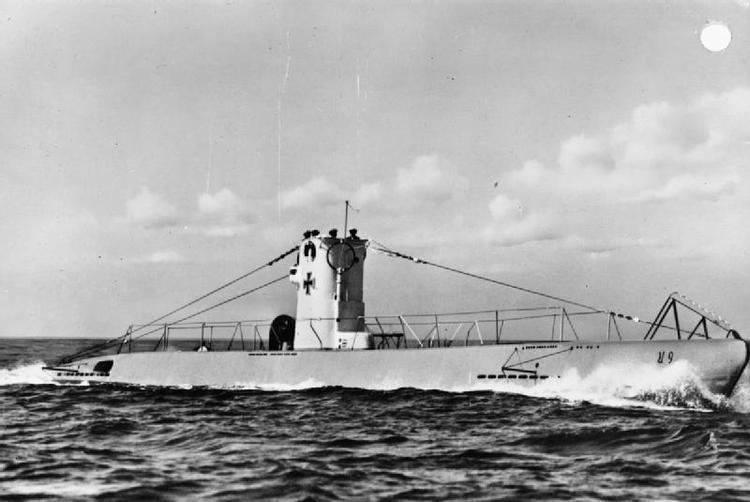Name U-22 Yard number 552 Commissioned 20 August 1936 Launched 29 July 1936 Draft 3.9 m | Ordered 2 February 1935 Laid down 4 March 1936 Construction started 4 March 1936 Length 43 m | |
 | ||
Builder Friedrich Krupp Germaniawerft Part of | ||
German submarine U-22 was a Nazi German Type IIB U-boat which was commissioned in 1936 following construction at the Germaniawerft shipyards at Kiel. Her pre-war service was uneventful, as she trained crews and officers in the rapidly expanding U-boat arm of the Kriegsmarine following the abandonment of the terms of the Treaty of Versailles two years before.
Contents
Design
German Type IIB submarines were enlarged versions of the original Type IIs. U-22 had a displacement of 279 tonnes (275 long tons) when at the surface and 328 tonnes (323 long tons) while submerged. Officially, the standard tonnage was 250 long tons (250 t), however. The U-boat had a total length of 42.70 m (140 ft 1 in), a pressure hull length of 28.20 m (92 ft 6 in), a beam of 4.08 m (13 ft 5 in), a height of 8.60 m (28 ft 3 in), and a draught of 3.90 m (12 ft 10 in). The submarine was powered by two MWM RS 127 S four-stroke, six-cylinder diesel engines of 700 metric horsepower (510 kW; 690 shp) for cruising, two Siemens-Schuckert PG VV 322/36 double-acting electric motors producing a total of 460 metric horsepower (340 kW; 450 shp) for use while submerged. She had two shafts and two 0.85 m (3 ft) propellers. The boat was capable of operating at depths of up to 80–150 metres (260–490 ft).
The submarine had a maximum surface speed of 12 knots (22 km/h; 14 mph) and a maximum submerged speed of 7 knots (13 km/h; 8.1 mph). When submerged, the boat could operate for 35–42 nautical miles (65–78 km; 40–48 mi) at 4 knots (7.4 km/h; 4.6 mph); when surfaced, she could travel 3,800 nautical miles (7,000 km; 4,400 mi) at 8 knots (15 km/h; 9.2 mph). U-22 was fitted with three 53.3 cm (21 in) torpedo tubes at the bow, five torpedoes or up to twelve Type A torpedo mines, and a 2 cm (0.79 in) anti-aircraft gun. The boat had a complement of twentyfive.
War Patrols
During the Second World War, she was mainly deployed for coastal work, a role enforced by her small size and endurance. Thus she was useful for operations in the North Sea and against the British coastal convoys, particularly along the north east seeboard of Great Britain. It was in this region that she scored her first successes, after fruitless operations off the Polish coast during the invasion of that country and a patrol against British shipping coming from Norwegian ports.
On 18 November 1939, she scored her first kill, sinking the tiny coastal cargo ship SS Parkhill off the Scottish coast. This was followed on her fourth patrol with two mine barrages off Blyth, in Northumberland, which claimed two coastal freighters and a naval patrol minesweeper in less than a week. She was then used directly against Scottish convoys in the Moray Firth, during which she achieved her greatest success, torpedoing the British destroyer HMS Exmouth, which went down with all hands, the cause of her loss only discovered by the British after the war. Shortly afterwards, in thick fog, she sank a Danish ship from the same convoy. These were her final direct victims, although she later claimed another with a mine laid sometime before.
The submarine failed to return from her seventh patrol, for which she had departed on 20 March 1940. There is some indication that she was lost due to an unexplained mine detonation in the Skagerrak. Some suggested, that she might have been rammed by the Polish submarine Wilk, which reported crashing into something, but it was a month later (20 June) and newest analyses show, that the Wilk most probably collided with a buoy. Whatever the cause, U-22 and her 27 crew were never seen again, lost somewhere in the North Sea in March 1940.
